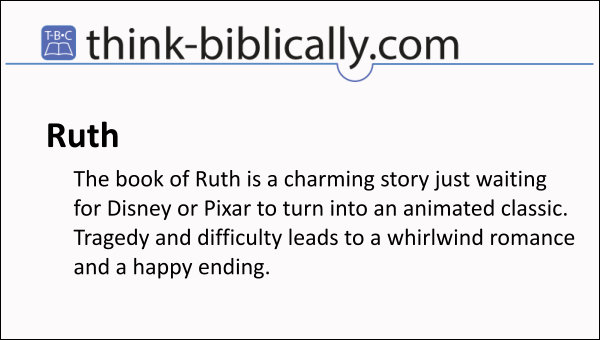By Tyson Thorne

The book of Ruth is a charming story just waiting for Disney or Pixar to turn into an animated classic. Tragedy and difficulty leads to a whirlwind romance and a happy ending. Along the way we meet interesting characters and foreign customs and witness acceptance, faithfulness and redemption. The book is enjoyable on this level, but become something more when we look deeper. Boaz's actions to redeem Ruth and her family name symbolize the work of Christ in the church. Jesus takes for himself a Gentile bride as described by Paul in his letter to the Ephesians:
But as the church submits to Christ, so also wives should submit to their husbands in everything. Husbands, love your wives just as Christ loved the church and gave himself for her to sanctify her by cleansing her with the washing of the water by the word, so that he may present the church to himself as glorious – not having a stain or wrinkle, or any such blemish, but holy and blameless.
While Ruth does not advance the history of Israel, it does give us insight into Israelite life during the time of the judges. The book of Leviticus provides important background to Ruth. For example, Leviticus 19.9-10 describes Israel's welfare system of "gleaning" and 25.25-49 teach the importance of the "kinsman redeemer" practice. The responsibility of Boaz to marry Ruth and father a child to keep the family name alive comes from Deuteronomy 25.5-10. Yet some of the custom's in the book have no explanation elsewhere in the Bible. Take Ruth's uncovering Boaz's feet at the beginning of chapter 4. While this was customary during the time, but isn't described anywhere else. Likewise, an exchange of a sandal between two parties to represent an exchange of property is also not noted elsewhere, though the Nuzi documents (an ancient Akkadian record) refers to a similar practice 500 years earlier.
Author and Date of Writing
Old Testament books rarely disclose authorship, often making a connection to the author difficult. To make a determination scholars always search the book for clues first then look to tradition, and we'll do no differently. Discovering an author means first pinning down the time the book was written. While the story of Ruth is about events that took place during the time of the Judges, King David is mentioned in 4.22 so the book had to have been written after the reign of King Saul. None of David's sons however, including Solomon, are not mentioned which suggests the book was written early during David's reign.
Our writer, therefore, had to have lived during the time of King David. Old Testament authors are often priests, kings or prophets. We know Samuel was a prophet and a writer, tracking Israel's history, and having contributed to other books of the Old Testament. Samuel was alive and old enough to have written Ruth during the reign of David. Add to this the fact that the Jewish Talmud attributes the authorship to Samuel and we have good cause to accept the prophet as the author of Ruth.
Big Idea
While the book of judges shows Israel turning from God and toward idol worship time after time, Ruth shows us a Gentile woman turning from her people's idols and to God, revealing that God can use anyone to accomplish good for his people.
Outline
I. Introduction, chapter 1.1-5
II. Ruth follows Naomi, Chapter 1.6-22
III. Ruth is faithful to Naomi, Chapter 2
IV. Ruth claims Boaz, chapter 3
V. Ruth redeemed by Boaz, chapter 4.1-12
VI. Conclusion, chapter 4.13-22